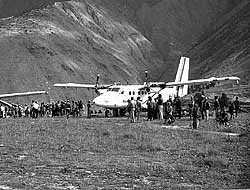 Even though more Twin Otter aircraft have been lost in accidents in Nepal in the past 15 years than any other aircraft type, aviation experts say the Canadian-built plane is still the most suitable equipment for Nepal.
Even though more Twin Otter aircraft have been lost in accidents in Nepal in the past 15 years than any other aircraft type, aviation experts say the Canadian-built plane is still the most suitable equipment for Nepal. The latest Twin Otter accident was the Shangri-la Air DHC-6 which crashed into a mountain just before landing in Pokhara during heavy monsoon showers last week killing three crew members and 15 tourists on board.
The Twin Otter was introduced to Nepal in 1970 as part of a Canadian aid project, and is the mainstay of the domestic fleet of Royal Nepal Airlines. The state-owned airline has six of the twin-engine short-take-off-and-landing (STOL) planes out of an original of twelve. Other private airlines also fly Twin Otters, and find the aircraft to be versatile on the short, sloping dirt airstrips in the mountains of Nepal.
"It is still the best aircraft to fly in Nepal," says George Nowak, of Acres International, a Toronto company which got a Canadian government conract to refurbish Royal Nepal's ageing Twin Otters last year. "We brought 20 years of life back to them," Nowak told the Toronto Globe and Mail. Nowak said there have been improvements in Nepal's aircraft-maintenance records, but pilots still face dangerous weather conditions flying in the Himalaya during the monsoons.
Between 1972 and 1979, the Canadian International Development Agency donated seven Twin Otters to Royal Nepal. Subsequent CIDA projects, which were vital to regional development and tourism in Nepal, focused on aircraft maintenance, pilot training, and building a hangar in Nepalganj.


